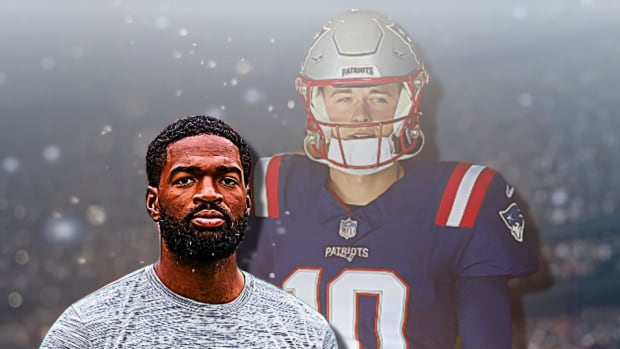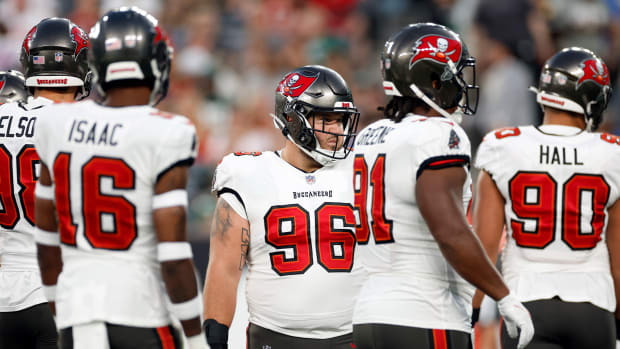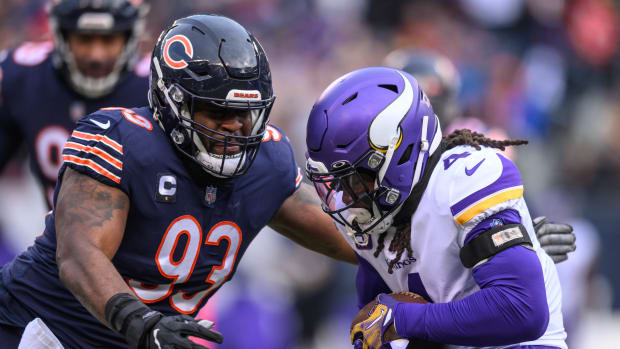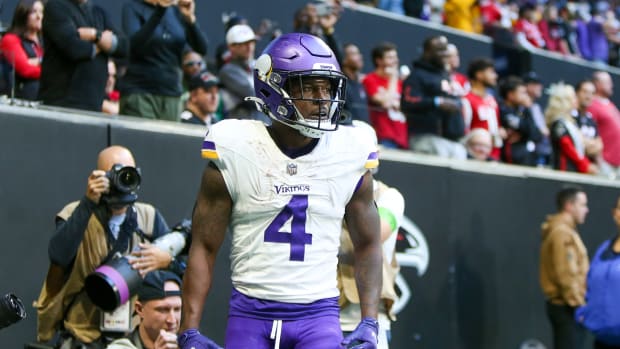The best players of the Super Bowl era by uniform number: Nos. 00–49
Can you picture Joe Montana dropping back to pass without seeing the No. 16 pop off his bright red 49ers jersey? Do you ever recall Walter Payton breaking loose on a run and not have his No. 34 pop into your mind?
Jersey numbers are oftentimes an afterthought, arbitrarily handed out to a player with little rhyme or reason. For the greats of the game, though, those numbers become part of their identity—a characteristic every bit as recognizable as a running style or throwing motion.
Much of this probably relates to how most of us experience the game in our youth. Aaron Rodgers wears No. 12, so every Wisconsin kid who dreams of someday slinging passes at Lambeau wants those digits on his or her jersey. A similar story no doubt has unfolded for Troy Polamalu's 43 in Baltimore or Peyton Manning's 18 in both Indianapolis and Denver.
• SI.com's off-season report cards: Grading every team's moves
So which names do we think of when it comes to each individual number? Below is the first half of our list, covering Nos. 00-49, honoring the greatest player at each spot (the best players ever to wear Nos. 50–99 can be found here).
• GALLERY: The NFL's best players by number, from 00 to 99
. Jim Otto
Center, Raiders
Not many players have sported the zero (or in this case, double-zero), but Otto just so happens to be one of the game's all-time great linemen. A 1980 Hall of Fame inductee, Otto was named to 12 Pro Bowls and 10 All-Pro teams. The final five of his 15 seasons came after Oakland moved into the NFL.
1. Warren Moon
QB, Oilers/Vikings/Seahawks/ Chiefs
Moon threw for 21,000-plus yards and won five championships as a pro ... before even beginning his 17-season NFL career. A CFL Hall of Famer, Moon also carved out an NFL Hall of Fame career. He ranks seventh in career passing yards (49,325) and eighth in passing touchdowns (291).
2. David Akers
K, Redskins/Eagles/49ers/ Lions
Akers led the NFL in scoring for an entire decade, posting 1,169 points from 2000–09. As a result, he was named to the second team of the Pro Football Hall of Fame's All-2000s roster. He ranks 11th all-time in career points (1,721). Could Matt Ryan eventually surpass Akers as the greatest No. 2 ever?
3. Jan Stenerud
K, Chiefs/Packers/Vikings
Russell Wilson may hold this honor before long. But for now, the choice comes down to Stenerud and ex-Bills/Raiders QB Daryle Lamonica. Give the nod to the Hall of Famer. Stenerud made 373 field goals and accounted for 1,699 points over a 19-year career.
4. Brett Favre
QB, Falcons/Packers/Jets/ Vikings
The recent (and repeat) SI cover boy should be a first-ballot Hall of Famer come February. He still holds myriad NFL records, including passes attempted, completions and passing yards. No. 4 also has been a favorite of many decorated kickers, among them Adam Vinatieri and Jason Hanson.
5. Donovan McNabb
QB, Eagles/Redskins/Vikings
The ‘Golden Boy,’ Paul Hornung, played just one season in the Super Bowl era (and won a title), so McNabb gets the spot. A remarkable athlete in his prime, the six-time Pro Bowler turned Philadelphia into a perennial contender.
6. Jay Cutler
A number reserved for good-not-great kickers (Kevin Butler, Rolf Benirschke) and serviceable-not-good quarterbacks (Bubby Brister, Mark Sanchez). So it's Cutler in this spot almost by default. In his defense, Cutler likely will finish his career in the league's top 20 for career passing yards.
7. John Elway
QB, Broncos
Ben Roethlisberger may be building a Hall of Fame case, and Morten Andersen certainly has one. Neither comes close to bumping Elway off the No. 7 mountaintop. Elway entered the Hall in 2004 after winning two Super Bowls and posting top 10 career marks in passing yards and touchdowns.
8. Steve Young
QB, Buccaneers/49ers
Probably our first real bit of controversy. Would you rather have Young or Troy Aikman under center? Both won a Super Bowl and a Super Bowl MVP. Both are in the Hall of Fame. But Young's numbers across the board—including as a runner—are astounding.
9. Drew Brees
QB, Chargers/Saints
Half of Hall of Famer Sonny Jurgensen's career came before the Super Bowl era, so the choice of Brees becomes a little easier, but not that Brees needs any extra help. Twice the NFL's Offensive Player of the Year, Brees ranks in the top five for career completions, attempts, passing yards and touchdowns.
10. Fran Tarkenton
QB, Vikings/Giants
Inducted into the Hall in 1986, Tarkenton was to the ’60s and ’70s what Steve Young was to the ’90s. His dual-threat abilities were unmatched for some time in the NFL, and he got better with age. Tarkenton's MVP win came in 1975, his 15th season.
11. Larry Fitzgerald
WR, Cardinals
Because he is approaching the tail end of his career (and because the NFL produces an endless stream of 1,000-yard receivers these days), Fitzgerald gets a little overlooked. He shouldn't be. The Hall of Fame probably awaits when he's done.
12. Tom Brady
QB, Patriots
This is the number to wear if you're a quarterback. There's Brady, Terry Bradshaw, Roger Staubach, Jim Kelly, Joe Namath, Bob Griese and Aaron Rodgers, among others. It's tough to pick against Brady, now a four-time Super Bowl winner and arguably the greatest quarterback ever.
13. Dan Marino
QB, Dolphins
All due respect to Kurt Warner and Don Maynard (whose career mostly spanned the pre-Super Bowl era), Marino is a shoo-in selection: Rookie of the Year, Player of the Year, 61,000 career passing yards, nine-time Pro Bowler, etc. etc. The lack of a Super Bowl ring is his lone blemish.
14. Dan Fouts
QB, Chargers
Sorry, Bengals fans (both Ken Anderson and Andy Dalton are No. 14s). Fouts is a Hall of Famer for a reason. He was a tremendous passer in a run-heavy era—Fouts still ranks top 15 in most major quarterback categories—and almost single-handedly changed the Chargers' fortunes.
15. Bart Starr
QB, Packers
The Super Bowl era cutoff would have been more of an issue for Starr had he not won MVP honors at Super Bowls I and II, two Packers victories. Starr also quarterbacked Green Bay to the 1961, ’62 and ’65 championships. He was member of the 1977 Hall of Fame class.
16. Joe Montana
QB, 49ers/Chiefs
Still the choice for many when asked to pick football's greatest quarterback. Montana was as clutch as they get—he was named Super Bowl MVP in three of the 49ers' four title wins under his leadership. The Hall of Fame added Montana in 2000.
17. Philip Rivers
QB, Chargers
Rivers can bring out some heated opinions, but truth be told he already has decent Hall of Fame credentials (nearly 37,000 yards passing and 252 touchdowns), possibly with several seasons left in his career. Other options at No. 17: WR Harold Carmichael and DB Richie Petitbon.
18. Peyton Manning
QB, Colts/Broncos
Surely, everyone is aware of Manning's credentials by now. When he retires (after this coming season?) the legendary quarterback likely will hold every major NFL passing record. He needs just 2,147 yards to pass Favre for first place as the league's all-time leading passer.
19. Johnny Unitas
QB, Colts/Chargers
Tightroping the Super Bowl-era line here—Unitas's greatest years came before the Super Bowl's inception for the 1966 season, and he played just four seasons following the 1970 AFL-NFL merger. Unitas, a 1979 Hall inductee, was a transcendent talent nonetheless.
20. Barry Sanders
RB, Lions
Was any player in NFL history more fun to watch? Often without much help from his teammates, Sanders jitterbugged his way to 15,000 career rushing yards. A special honorable mention for the DBs here—Ed Reed, Ronde Barber, Brian Dawkins and Lem Barney all wore No. 20.
21. Deion Sanders
CB, Falcons/49ers/Cowboys/ Redskins/Ravens
An argument can be made for LaDainian Tomlinson, a dominant RB for years and a likely 2017 Hall of Famer. Sanders, though, might be the NFL's greatest cover corner, and he previously held a record with 19 career return touchdowns.
22. Emmitt Smith
RB, Cowboys/Cardinals
Frank Gore needs another 7,000 yards or so. Adrian Peterson is still 8,000 away. In other words, Smith's all-time rushing record of 18,355 yards is safe for the foreseeable future. Smith, a 2010 Hall of Famer, rushed for at least 1,000 yards in 11 different seasons.
23. Devin Hester
WR/KR, Bears/Falcons
While Hester does have 255 career catches, he tops the No. 23 group because of his prowess as a return man. Last season's 62-yarder against Tampa Bay was his record 20th return touchdown. He's a spectacular game-changer.
24. Champ Bailey
CB, Redskins/Broncos
There are a handful of Hall of Famers who wore No. 24—Willie Brown, Willie Wood, Lenny Moore. A 12-time Pro Bowler, Bailey will join them eventually, though he's not eligible until 2019. His 10-interception season in 2006 was downright stunning.
25. Fred Biletnikoff
WR, Raiders
Biletnikoff played two more seasons after the Raiders' Super Bowl XI win, but his MVP performance in that game was the true culmination of a special career. En route to a 1988 Hall induction, the Raiders legend caught 589 passes and scored 76 times.
26. Rod Woodson
Raiders
Woodson intercepted 38 passes during his 10 seasons in Pittsburgh. Later, he led the league in picks with the Ravens (seven in 1999) and did it again, at age 37, as a Raider (eight in 2002). He earned a 2009 call to the Hall of Fame.
27. Steve Atwater
DB, Broncos/Jets
Atwater has been a Hall of Fame semifinalist on multiple occasions without breaking through. Does he deserve more credit? The hard-hitting safety helped anchor Denver's defense for a decade and landed on the Hall's All-1990s team. Also sporting No. 27: 10,000-yard back Eddie George.
28. Marshall Faulk
RB, Colts/Rams
Another number that can boast some gems, including Hall of Famers Curtis Martin and Yale Lary. But this one boils down to Faulk vs. Darrell Green. Faulk's numbers are plain silly: from 1998-2001, spanning two teams, he averaged 2,248 yards from scrimmage and 17.3 TDs. His 2,429 yards in 1999 stood as the league record until Chris Johnson topped him a decade later.
29. Eric Dickerson
RB, Rams/Colts/Raiders/Falcons
Dickerson still sits top 10 in career rushing yards, with 13,259—a staggering 3,913 of those coming during his first two NFL seasons. The 2,105 yards he posted as a second-year player still stands as the single-season benchmark. Dickerson was voted into the Hall of Fame in 1999.
30. Terrell Davis
RB, Broncos
How much does longevity count toward an NFL player's legacy? Davis' career essentially was limited to four seasons (1995-98); a 1999 knee injury robbed him of much beyond that time. He still managed to win two Offensive Player of the Year awards, a league MVP (2,008 yards and 21 TDs in 1998), a Super Bowl MVP and two championships.
31. Donnie Shell
S, Steelers
Despite rushing for 10,000 career yards, Jamal Lewis, another No. 31, is not bound for Canton. Shell—a 2002 finalist—does not seem likely to get there either, even with a stronger Hall résumé. As a starter beginning in the second half of Pittsburgh's 1970s dynasty, Shell was the type of rangy, box safety teams still covet.
32. Marcus Allen
RB, Raiders/Chiefs
The final season of Jim Brown's career (1965) coincided was the last without a Super Bowl, so while deserving he cannot be considered. Allen would be in the mix even if Brown was eligible. The versatile 2003 Hall of Famer accounted for 17,654 yards from scrimmage and 144 touchdowns. He narrowly edges out fellow Hall member O.J. Simpson.
33. Tony Dorsett
RB, Cowboys/Broncos
Dorsett took home the Rookie of the Year in 1977 and maintained that excellence for nine-plus years before Father Time caught up to him. All told, the 1994 Hall inductee rushed for 90 touchdowns and nearly 13,000 yards in the regular season, plus another 1,383 yards and 10 scores in the playoffs.
34. Walter Payton
RB, Bears
Payton, Thurman Thomas, Earl Campbell and Herschel Walker—all wearers of No. 34—combined for more than 46,000 yards rushing. Payton churned out 16,726 himself, along with another 4,500 receiving and 125 touchdowns. He is one of football's greatest players ever, period.
35. Aeneas Williams
DB, Cardinals/Rams
Williams defined the term ‘ballhawk’—he intercepted 55 passes and recovered 23 fumbles during his Hall of Fame career. He led the league with nine interceptions in 1994, the first of his eight Pro Bowl years.
36. Jerome Bettis
RB, Rams/Steelers
Never a highlight-reel back like Sanders, Dickerson or Payton, Bettis instead bulldozed his way to 13,662 career yards rushing. A 1996 move from St. Louis to Pittsburgh revitalized his career and helped him win Comeback Player of the Year. His long Hall wait ended in 2014 after four near-misses as a finalist.
37. Jimmy Johnson
DB, 49ers
Think of Johnson as the Richard Sherman of his era—quarterbacks preferred to avoid him rather than test him. Johnson made them pay when passes headed his direction, too, picking off 47 passes for his career. Another contender for No. 37: Hall of Fame contender Rodney Harrison.
38. Bob Tucker
TE, Giants/Vikings
A bit of a lull after so many numbers loaded with Hall of Fame histories. No. 38 features brief stars like Rookie of the Year honorees George Rogers (1981) and Mike Anderson (2000). Tucker, though, was a bit ahead of his time as a pass-catching tight end. Tucker amassed most of his 422 receptions on miserable Giants squads, topping out with an NFC-best 59 grabs in 1971.
39. Larry Csonka
RB, Dolphins/Giants
Aside from coach Don Shula, Csonka probably is the face of the Dolphins’ 1970s teams for a lot of fans. The 1987 Hall inductee had his best statistical season (1,117 yards rushing) during Miami's ’72 undefeated run to the Super Bowl.
40. Gale Sayers
RB, Bears
This spot very nearly fell to Mike Alstott, Tampa Bay's six-time Pro Bowl fullback. But bypassing Sayers would be ignoring one of the most talented players to suit up in the NFL. Were it not for a knee injury in 1968, who knows how great Sayers could have been. The Hall of Fame saved a spot for him anyway, on the basis of what he accomplished over four and a half seasons before injuries ended his career.
41. Lorenzo Neal
FB, Saints/Jets/Buccaneers/ Titans/Bengals/Chargers/Ravens
A fullback lands on the list, one spot after Alstott's snub. Neal played for what felt like every team in the league during a career that spanned 1993-2008. He could pick up a few yards or catch a pass, but Neal thrived doing the dirty work. Voters placed him on the Pro Football Hall of Fame's All-2000s team.
42. Ronnie Lott
S, 49ers/Raiders/Jets
Lott led the league with eight interceptions in 1991, his first season with Oakland. The 10 years before that in San Francisco defined his career, however. A 10-time Pro Bowler, six-time All-Pro and 2000 Hall inductee, Lott could play—and dominate from—any position in the secondary.
43. Troy Polamalu
S, Steelers
It is impossible to talk about safeties in the modern era without discussing Polamalu's impact. How many touchdowns did he save the Steelers? How many games did he alter with one timely, amazing play? Polamalu will be in the Hall, though the clock just started ticking with his retirement this off-season.
44. John Riggins
RB, Jets/Redskins
Fascinating collection of players at No. 44—Hall of Famers Dick LeBeau, Floyd Little and Leroy Kelly all took that number. A Hall of Famer himself and a Super Bowl MVP, Riggins had a longer, more productive career than all of them. His 104 rushing touchdowns ranks sixth all time; his 11,352 yards rushing currently place him 17th.
45. Kenny Easley
DB, Seattle Seahawks
Ask just about any longtime Seahawks fan and they'll tell you Easley deserves a spot in Canton. He likely would have claimed one had a kidney disease not ended his career after seven seasons. The heavy-hitting safety made the Pro Bowl five times during that stretch, picking off 32 passes in the process.
46. Tim McDonald
S, Cardinals/49ers
A few more solid, overlooked players shared the No. 46. McDonald, who started 187 games and earned six Pro Bowl bids from 1987–99, is one. Another: Raiders tight end Todd Christensen. He twice led the league in receptions (1983 and '86) and caught 461 passes for his career.
47. John Lynch
S, Buccaneers/Broncos
Should a contrarian prefer Hall of Fame Steelers cornerback Mel Blount, it would be very understandable. Blount was a lock-down defender for more than a decade. Lynch, though, should join him in the Hall. Whether he will or not is another story—the Tampa Bay great has fallen short twice as a finalist—but his impact on the Bucs' defense impact was profound. Lynch excelled outside of Tampa Bay, too, closing his career with four straight Pro Bowls as a Bronco. The hard-hitting Lynch was a deserving nine-time Pro Bowler.
48. Daryl Johnston
RB, Cowboys
Would Emmitt Smith's career have reached such historic heights without Johnston blocking for him? Perhaps, but "Moose" was a catalyst for the Cowboys' run game throughout the '90s. Johnston also caught 294 passes and scored 22 touchdowns.
49. Dennis Smith
S, Broncos
Pure safeties always have had a difficult time getting to the Hall (see Lynch above), so Smith has remained an afterthought despite 14 impressive seasons and six Pro Bowl nods with Denver. Hall of Fame receiver Bobby Mitchell also wore No. 49, but just three of his seasons occurred in the Super Bowl era. Mitchell was at his most electrifying from 1962–63.





























































